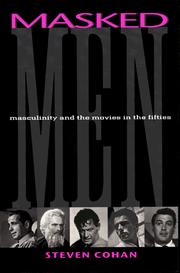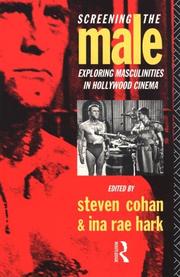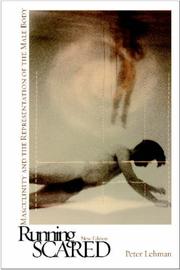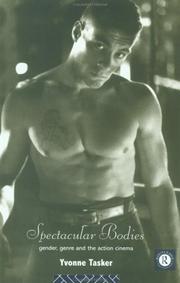| Listing 1 - 10 of 24 | << page >> |
Sort by
|

ISBN: 0585026238 9780585026237 0253332974 0253211271 9780253332974 9780253211279 Year: 1997 Publisher: Bloomington Indiana University Press
Abstract | Keywords | Export | Availability | Bookmark
 Loading...
Loading...Choose an application
- Reference Manager
- EndNote
- RefWorks (Direct export to RefWorks)
Men in motion pictures. --- Masculinity --- Masculinity (Psychology) --- Sex (Psychology) --- Men --- Motion pictures --- History
Book
ISBN: 0522872484 9780522872484 Year: 2019 Publisher: Carlton, Victoria, Australia
Abstract | Keywords | Export | Availability | Bookmark
 Loading...
Loading...Choose an application
- Reference Manager
- EndNote
- RefWorks (Direct export to RefWorks)
Set against the shifting social and political backdrop of a nation throwing off the shackles of one war yet faced with the instability of the new world order, Reel Men probes the concept of 1950s masculinity itself, asking what it meant to be an Australian man at this time. Offering a compelling exploration of the Australian fifties, the book challenges the common belief that the fifties was a 'dead' era for Australian filmmaking. Reel Men engages with fourteen Australian feature films made and released between 1949 and 1962, and examines the multiple masculinities in circulation at this time. Dealing with beloved Australian films like Jedda (1955), Smiley (1956), and The Shiralee (1957), and national icons of the silver screen including Chips Rafferty, Charles 'Bud' Tingwell, and Peter Finch, Reel Men delves into our cultural past to dismantle powerful assumptions about film, the fifties, and masculinity in Australia.
Masculinity in motion pictures. --- Men in motion pictures. --- Motion pictures --- History

ISBN: 1283606054 9786613918505 1134900104 0203142217 9781134900107 9780203142219 0415077583 9780415077583 0415077591 9780415077590 9781134900053 1134900058 9781134900091 1134900090 9781138169517 113816951X 9781283606059 6613918504 Year: 1993 Publisher: London New York Routledge
Abstract | Keywords | Export | Availability | Bookmark
 Loading...
Loading...Choose an application
- Reference Manager
- EndNote
- RefWorks (Direct export to RefWorks)
Screening the male re-examines the problematic status of masculinity both in Hollywood cinema and feminist film theory.Classical Hollywood cinema has been theoretically established as a vast pleasure machine, manufacturing an idealized viewer through its phallocentric ideological apparatus. Feminist criticism has shown how difficult it is for the female viewer to resist becoming implicated in this representational system. But the theroies have overlooked the significance of the problem itself - of the masuline motivation at the core of the system. The essays here explore those mal
Men in motion pictures. --- Sex in motion pictures. --- Sex in moving-pictures --- Motion pictures --- Erotic films --- Pornographic films

ISBN: 081433556X 9780814335567 9780814333396 0814333397 Year: 2007 Publisher: Detroit Wayne State University Press
Abstract | Keywords | Export | Availability | Bookmark
 Loading...
Loading...Choose an application
- Reference Manager
- EndNote
- RefWorks (Direct export to RefWorks)

ISBN: 1281294993 9786611294991 1847141498 9781847141491 9780826486523 0826486525 0826486525 9781281294999 6611294996 1847062628 Year: 2006 Publisher: London New York Continuum
Abstract | Keywords | Export | Availability | Bookmark
 Loading...
Loading...Choose an application
- Reference Manager
- EndNote
- RefWorks (Direct export to RefWorks)
Looks at a range of fiction and film texts, since 1950's, in order to analyse the ways in which masculinity has been represented in popular culture in Britain and the United States. This work covers numerous genres, including spy fiction, science fiction, the Western and police thrillers.
Book
ISBN: 1283206781 9786613206787 1441166882 9781441166883 9781283206785 9780826499554 0826499554 6613206784 Year: 2008 Publisher: London New York, NY Continuum
Abstract | Keywords | Export | Availability | Bookmark
 Loading...
Loading...Choose an application
- Reference Manager
- EndNote
- RefWorks (Direct export to RefWorks)
Male Jealousy: Literature and Film is a critical and cultural theory-based study of male jealousy in western culture and its connections with paranoia. By tracing the meanings of jealousy and the representation of jealous men (married or unmarried, heterosexual or homosexual), Lo argues that jealousy is promoted within patriarchy and within what Derrida characterises as logocentricism, where to love is the desire to be loved, and where love cannot be guaranteed in any form of sexual relationship. Contrasting the difference between jealousy and its closely linked concept, envy, this book explor
Jealousy in literature. --- Men in literature. --- European literature --- Jealousy in motion pictures. --- Men in motion pictures. --- Motion pictures --- History and criticism.
Book
ISBN: 1442275650 1442233591 9781442233591 9781442233584 1442233583 9781442275652 Year: 2014 Publisher: Lanham
Abstract | Keywords | Export | Availability | Bookmark
 Loading...
Loading...Choose an application
- Reference Manager
- EndNote
- RefWorks (Direct export to RefWorks)
This volume examines films produced by Pixar Animation Studios between 1995 and 2013, exploring how boys become men and how men measure up in films from Toy Story to Monsters University. Offering counterintuitive readings of such works, this book describes how the films quietly but forcefully reiterate traditional masculine norms, in terms of what they praise and what they condemn.
Masculinity in motion pictures. --- Men in motion pictures. --- Animated films --- Motion pictures --- History and criticism. --- Pixar (Firm) --- Pixar Animation Studios --- Disney Pixar (Firm)
Book
ISBN: 1845452399 178238216X 1845455401 1299777880 Year: 2008 Publisher: New York : Berghahn Books,
Abstract | Keywords | Export | Availability | Bookmark
 Loading...
Loading...Choose an application
- Reference Manager
- EndNote
- RefWorks (Direct export to RefWorks)
Gender, especially masculinity, is a perspective rarely applied in discourses on cinema of Eastern/Central Europe. Masculinities in Polish, Czech and Slovak Cinema exposes an English-speaking audience to a large proportion of this region's cinema that previously remained unknown, focusing on the relationship between representation of masculinity and nationality in the films of two and later three countries: Poland, Czechoslovakia/the Czech Republic and Slovakia. The objective of the book is to discuss the main types of men populating Polish, Czech and Slovak films: that of soldier, f
Men in motion pictures. --- Masculinity in motion pictures. --- Motion pictures --- Cinema --- Feature films --- Films --- Movies --- Moving-pictures --- Audio-visual materials --- Mass media --- Performing arts --- History and criticism

ISBN: 0415092248 1280323221 0203221842 1134873018 9781134873012 9780203221846 9781134872961 1134872968 9781134873005 113487300X 041509223X 9780415092234 9780415092241 9781280323225 0203305159 Year: 1993 Publisher: London New York Routledge
Abstract | Keywords | Export | Availability | Bookmark
 Loading...
Loading...Choose an application
- Reference Manager
- EndNote
- RefWorks (Direct export to RefWorks)
While films such as Rambo, Thelma and Louise and Basic Instinct have operated as major points of cultural reference in recent years, popular action cinema remains neglected within contemporary film criticism. Spectacular Bodies unravels the complexities and pleasures of a genre often dismissed as `obvious' in both its pleasure and its politics, arguing that these controversial films should be analysed and understood within a cinematic as well as a political context. Yvonne Tasker argues that today's action cinema not only responds to the shifts in gendered, sex
Strong men in motion pictures. --- Sex role in motion pictures. --- Machismo in motion pictures. --- Action and adventure films --- Action-adventure films --- Action cinema --- Action films --- Action movies --- Adventure and action films --- Adventure films --- Adventure movies --- Motion pictures --- Swashbuckler films --- Strong men in motion pictures --- Sex role in motion pictures --- Machismo in motion pictures
Book
ISBN: 1283383217 9786613383211 0813550297 9780813550299 0813548020 9780813548029 9781283383219 661338321X Year: 2010 Publisher: New Brunswick, NJ
Abstract | Keywords | Export | Availability | Bookmark
 Loading...
Loading...Choose an application
- Reference Manager
- EndNote
- RefWorks (Direct export to RefWorks)
Titanic. Two Moon Junction. A Night in Heaven. Sirens. Henry & June. 9 Songs. Lady Chatterley. And more. A new "body guy" genre has emerged in film during the last twenty years-a working-class man of the earth or bohemian artist awakens and fulfills the sexuality of a beautiful, intelligent woman frequently married or engaged to a sexually incompetent, educated, upper-class man. This body guy exhibits a masterful athletic, penile-centered sexual performance that enlivens and transforms the previously discontented woman's life. Peter Lehman and Susan Hunt relate a host of wide-ranging films to a literary tradition dating back to D. H. Lawrence's Lady Chatterley's Lover and an emerging body culture of our time. Through an engaging and compelling narrative, they argue that the hero's body, lovemaking style, and penis-revealed through extensive male nudity-celebrate conformity to norms of masculinity and male sexuality. Simultaneously, these films denigrate the vital, creative, erotic world of the mind. Just when women began to successfully compete with men in the workplace, these movies, if you will, unzip the penis as the one thing women do not have but want and need for their fulfillment. But Lehman and Hunt also find signs of a yearning for alternative forms of sexual and erotic pleasure in film, embracing diverse bodies and vibrant minds. Lady Chatterley's Legacy in the Movies shows how filmmakers, spectators, and all of us can be empowered to dethrone the body guy, his privileged body, and preferred style of lovemaking, replacing it with a wide range of alternatives.
Men in motion pictures. --- Women in motion pictures. --- Stereotypes (Social psychology) in motion pictures. --- Sex in motion pictures. --- Sex role in motion pictures. --- Motion pictures --- Stereotype (Psychology) in motion pictures --- Sex in moving-pictures --- Erotic films --- Pornographic films
| Listing 1 - 10 of 24 | << page >> |
Sort by
|

 Search
Search Feedback
Feedback About UniCat
About UniCat  Help
Help News
News